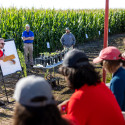New facility offers more than soil analysis
The Soil and Plant Analysis Laboratory‘s new facility provides services never dreamed of by the state legislators who, in 1913, mandated a soil testing facility for Wisconsin farmers.
Initially established to evaluate soil fertility to help determine plant nutrient needs, the lab has added plant analyses, and lawn and garden soil testing, allowing producers to optimize nutrient applications and homeowners to pinpoint their lawns’ fertilizer requirements.
But now, the lab also offers analytical services for campus researchers as well — ion chromatography, HPLC fluorescence and a host of other tests.
UW–Madison researchers are invited to the official opening of the lab’s new 8,000-square-foot facility, today (Wednesday, March 31) from 10 a.m.-2 p.m. at the West Madison Agricultural Research Station.
“We can do much more than just plant tissue and soils, and (we) have a lot of flexibility with our staff and facility, both in modifying what we do and in adopting new techniques,” says lab director Sherry Combs.
“The lab can now provide more ‘customized’ analytical methods, ranging from modifying sample preparation in the lab to staff developing protocols for clients to use at their own facility,” Combs says. “These project-based consulting services help clients produce results quickly and overcome possible staffing, equipment and/or expertise limitations.”
Some of the lab’s instrumentation and the staff’s analytical experience include spectrometry, stable isotope ratio determination, hydride sample preparation, flow injection analysis, accelerated solvent extraction, carbon analysis and microwave digestion systems.
Two experienced instrumentation specialists, Ibrahim Saeed and Ling Zhang, are available for project-based consulting and developing analytical services.
Samples can be dropped off at the Department of Soil Science for daily pickup. Researchers can submit sample information online. They receive a barcode for each sample set that will be scanned at the lab, enabling all unique sample identification to be retained and available on the report.
Tags: research




